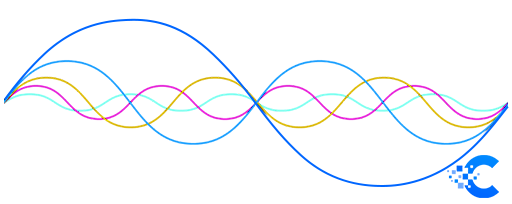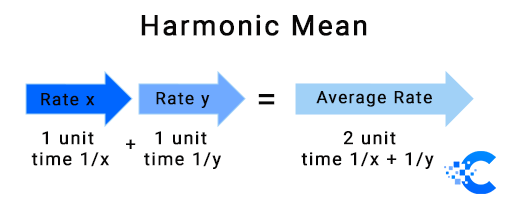We are all familiar with the concept of arithmetic mean and its calculation method by dividing the sum of values by the number of values. This way, we present a new Calcon calculator that helps calculate the harmonic mean. The simplest explanation for a harmonic environment would be that it measures the average of a group of element numbers divided by the number of reciprocal values of those elements. To begin with, we will explain what a measure of the harmonic environment refers to, its use, and how you can use our calculator to calculate this measure.
Take a look other related calculators, such as:
- Phase shift calculator
- 30 60 90 triangle calculator
- 45 45 90 triangle calculator
- Power reducing formula calculator
- Probability calculator 3 events
- Cofunction calculator
- Sum and difference identities calculator
- Trigonometry calculator
- Segment addition postulate calculator
- Fundamental counting principle calculator
- Condensing logarithms calculator
- Population density calculator
What is harmonic mean?
The type of numerical average most commonly used to calculate the average rate or rate of change is the harmonic mean. It is defined as the reciprocals of the arithmetic mean of reciprocity, which would mean calculating the division of the number of observations in a given data set by the sum of its reciprocals of each observation. Dividing the number of terms in a series of data by the sum of all reciprocal members will give the harmonic mean value. It gives less weight to higher values and vice versa to establish the right balance. Together with the arithmetic mean and the geometric mean, these three terms make up the Pythagorean means. They are significant in use in the fields of geometry and music. For a harmonic environment, we can say that it is also used to measure central tendency to determine a value that describes the behavior of data around the mean. The harmonic environment shows the lowest value of the mentioned Pythagorean environments. A measure to calculate the ratio or rate (e.g., calculating the average travel speed over some time) is often used because it can equalize each data point’s weight. In finance, this measure is used to calculate the price-earnings ratio. Using a harmonic environment, you can find multiplicative relationships between fractions.

How to calculate the harmonic mean?
The process of calculating the harmonic mean is solved in several steps:
if you have a given set of certain numbers: 5, 15, 30, 45, and you need to find a harmonic mean, the first thing you will do is find a common denominator for these numbers, which in this case is 90. The next step you need to do is to find the sum of the reciprocals of these numbers:
\frac{1}{5}+\frac{1}{15}+\frac{1}{30}+\frac{1}{45} = \frac{18}{90}+\frac{6}{90}+\frac{3}{90}+\frac{2}{90} = \frac{29}{90}Since this is a set of four elements, it is necessary to take this into account as follows:
\frac{4}{\frac{29}{90}} = \frac{4\cdot 90}{29} = 12.41Please note that when calculating the harmonic mean, you will not get a result if one of the elements of the set of numbers is 0. When calculating the harmonic mean using our calculator, this whole process comes down to just a few steps. The calculator contains predicted fields where you need to enter values depending on how many numbers your set contains. The calculator will do everything else and show you the final result.
Harmonic mean formula
The calculation of the harmonic mean is done with the formula:
\large H = \large \frac {n} {\large \frac {1} {x_1}+\frac {1} {x_2}+\frac {1} {x_3}+...+\frac {1} {x_n}}It is a series of positive numbers that are not zero, for which the harmonic mean will be where we have n number of items, and x1 … x2 represents the numbers of the string. You need to divide the number of elements in the sequence by the number of their reciprocals.
Harmonic average of two or three numbers
If you want to calculate the harmonic mean of two numbers x and y, and if they are nonzero, you need to enter the values in the following formula:
\large H = \large \frac {2\cdot x_1 \cdot x_2} {x_1+x_2}Since it is a set of real numbers, we can conclude that when the number of unknowns is equal to 2, the value of the harmonic mean will always be less than or equal to the geometric mean.

Example:
x = 4, y = 6 H = \frac{2\cdot 4\cdot 6}{4+6} = \frac{48}{10} = 4.8The harmonic mean for x and y is 4.8.
When we have three real, non-negative numbers, we calculate the harmonic mean according to the following formula:
\large H = \large \frac {3\cdot x_1 \cdot x_2 \cdot x_3} {x_1 \cdot x_2 + x_1 \cdot x_3 + x_2 \cdot x_3}Example:
x = 2, y = 4, z = 15 H = \frac{3\cdot 2\cdot 4\cdot 15}{2\cdot 4 + 4\cdot 15 + 15\cdot 2} = \frac{360}{98} = 3.67The harmonic mean for x, y, z in this case is 3.67.
Weighted harmonic mean
We also distinguish the so-called weighted harmonic mean type, which is a particular type where all weights are equal to the number 1. It is used when it is necessary to find the average of a set of observations giving each point equal weight. This can be calculated using the formula presented below:
\large H =\large \frac {\sum_{i=1}^{n} w_i} {\sum_{i=1}^{n} \frac {w_i} {x_i}} = \left ( \frac {\sum_{i=1}^{n} w_i \cdot x_i^{-1}} {\sum_{i=1}^{n} w_i} \right )^{-1}Applications of the geometric mean and harmonic mean
The use of geometric meanings can be seen in many fields. In statistics, it is calculated by raising the product of a specific string of numbers to the inverse value of the string length. It is also used in the finance sector to calculate a securities portfolio’s growth rate and yield. We can apply the geometric mean to calculate the annual return on the securities portfolio and construct many stock exchange indices regardless of their market price. It is also used for sets of numbers where the product of those numbers gives exponential values. As for the harmonious environment, it is a handy tool in the financial sector. Using harmonic mean, Fibonacci sequence patterns, you can determine average multiples to calculate velocity and find the average rate value. Because the harmonic medium is the most accurate in the calculation, it is also used to evaluate the performance of machines and computer systems. It also finds its application in finding the exact density and mass of particles in chemical analyses and tests to calculate the effects of fluctuation on the genetic population.
Disadvantages of the harmonic mean
This method, in addition to many advantages, has some disadvantages. The first thing needed to calculate the harmonic mean is to know all the array elements. If there is some unknown, it will not be possible to determine the harmonic environment. The calculation process can sometimes take longer, and certain complications can occur. You should also note that you cannot calculate the harmonic mean if any array members are equal to zero. If there are extreme values in the array, they will significantly impact the value of the harmonic mean.
Difference between geometric mean and harmonic mean in statistics
The geometric mean is used to calculate the average of a set of product numbers. It is most often used when working with percentages. The essence is that to find the geometric mean, and we need to multiply numbers. After that, if we want to change the size of the product to the range of the data set, we need to use rooting. It is important to mention also that the geometric mean is not always equal to the median, but only in exceptional cases. It gives more precise mean values than the arithmetic means, but not the harmonic mean. The geometric mean values are always more significant than the harmonic mean, and the harmonic mean will always result in the lowest values concerning all three means.
FAQ?
1. When do we use harmonic mean?
The most common use of a harmonic medium can be manifested when we want to find and calculate the reciprocal of the average of all mutual elements of an array.
2. The harmonic mean of 2 numbers
When calculating the harmonic mean between two numbers, x, and y, it is then defined as H = 2 \div ( \frac {1} {x} + \frac {1} {y} ) . From this formula, we can conclude that the harmonic mean of two numbers represents the reciprocal value of the arithmetic mean of the reciprocal values of the given numbers. This can still be written this way: H = \frac {2 \cdot x \cdot y} {x+y}
3. Harmonic mean equation
The universal formula for calculating the harmonic mean has the following appearance:
Harmonic \; Mean = n \div (\frac {1} {x_1} + \frac {1} {x_2} + \frac {1} {x_3} + …………+ \frac {1} {x_n} )
or
Harmonic \; Mean = n \div ( \frac { ?1} { x_i} )
where:
X1, X2,… Xn – Data Points
n – Total number of data points
n – the number of values in a dataset
x_i – the point in a dataset.
4. Application of harmonic mean in real life
You can use the harmonic mean to calculate the average speed of a car that travels the same distance at several specific speeds. In that case, dividing the standard length with each of the selected speeds is necessary and adding up the obtained values. The speed that would require the same realized time for the whole distance represents the harmonic mean of the speed.
